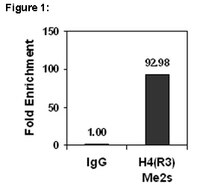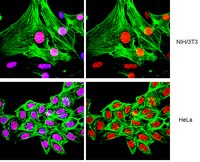17-10250 Sigma-AldrichChIPAb+™ Dimethyl-Histone H4 (Arg3) Symmetric - ChIP Validated Antibody and Primer Set
This ChIPAb+ Dimethyl-Histone H4 (Arg3) Symmetric -ChIP Validated Antibody & Primer Set conveniently includes the antibody & the specific control PCR primers.
More>> This ChIPAb+ Dimethyl-Histone H4 (Arg3) Symmetric -ChIP Validated Antibody & Primer Set conveniently includes the antibody & the specific control PCR primers. Less<<Recommended Products
Overview
| Replacement Information |
|---|
Key Specifications Table
| Species Reactivity | Key Applications |
|---|---|
| H, M, R | DB, WB, ChIP |
| References |
|---|
| Product Information | |
|---|---|
| Format | Affinity Purified |
| Control |
|
| Presentation | Anti-Dimethyl-Histone H4 (Arg3) Symmetric (rabbit polyclonal). One vial containing 17.5 µg of purified rabbit polyclonal in buffer containing 0.1 M Tris-Glycine (pH 7.4), 150 mM NaCl with 0.05% sodium azide before the addition of glycerol to 30%. Store at -20°C. Concentration: 0.7 µg/µL Normal Rabbit IgG. One vial containing 125 µg of Rabbit IgG in 125 µL of storage buffer containing 0.05% sodium azide. Store at -20°C. ChIP Primers, human β-globin. One vial containing 75 μL of 5 μM of each primer specific for the human β-globin promoter. Store at -20°C. FOR: AGG ACA GGT ACG GCT GTC ATC REV: TTT ATG CCC AGC CCT GGC TC |
| Quality Level | MQ100 |
| Physicochemical Information |
|---|
| Dimensions |
|---|
| Materials Information |
|---|
| Toxicological Information |
|---|
| Safety Information according to GHS |
|---|
| Safety Information |
|---|
| Packaging Information | |
|---|---|
| Material Size | 25 assays |
| Material Package | 25 assays per set. Recommended use: 0.7 μg of antibody per chromatin immunoprecipitation (dependent upon biological context). |
| Transport Information |
|---|
| Supplemental Information |
|---|
| Specifications |
|---|
| Global Trade Item Number | |
|---|---|
| Catalog Number | GTIN |
| 17-10250 | 04053252592348 |
Documentation
ChIPAb+™ Dimethyl-Histone H4 (Arg3) Symmetric - ChIP Validated Antibody and Primer Set SDS
| Title |
|---|
ChIPAb+™ Dimethyl-Histone H4 (Arg3) Symmetric - ChIP Validated Antibody and Primer Set Certificates of Analysis
Brochure
| Title |
|---|
| Advance your Epigenetics Research |













